

Memory Foam
Best For
- Usually better at isolating motion
- More dramatic body contouring and pressure relief
- No noise
Considerations
- May have worse edge support
- Memory foam can sometimes retain heat
Spring & Coil
Best For
- Usually faster response time and less exacting hugging contour
- Typically more bounce
- Better edge support
Considerations
- May have more motion transfer than foam
- Generally has a more restrained and generalized body contour
Summary
Memory foam vs. spring mattresses—which is right for you? Between these two mattress types, both offer a different feel and performance.
Based on our tests, memory foam mattresses offer lower motion transfer and less bounce. Spring mattresses tend to have faster response time, higher bounce, better edge support, and are better for sex.
The final call really comes down to the feel. If you like the feel of deeper hug and contour, memory foam is the right pick. But if you want a mattress that is responsive and actively changing… never a “stuck” feeling, springs are the better option.
In This Comparison
Best Models | Comparison | Memory Foam | Spring + Coil | Summary | FAQ
Best Memory Foam Mattresses
| Mattress | Score | Read Review | Check Price |
|---|---|---|---|
| Amerisleep AS3 Foam | 9.64 | Read Review | Check Price |
| BedInABox | 9.62 | Read Review | Check Price |
| Zoma | 9.62 | Read Review | Check Price |
| BedInABox Eco-Lux | 9.57 | Read Review | Check Price |
| Loom & Leaf | 9.56 | Read Review | Check Price |
Best Coil & Spring Mattresses
| Mattress | Score | Read Review | Check Price |
|---|---|---|---|
| Winkbed | 9.95 | Read Review | Check Price |
| Saatva | 9.95 | Read Review | Check Price |
| Winkbed Plus | 9.82 | Read Review | Check Price |
Are Memory Foam or Spring Mattresses Better?
We conduct data-driven and objective tests for every mattress we review (see how we test here). Each mattress has 33 individual data points that are recorded and analyzed.
The comparison chart below looks at the average performance for each category based on all memory foam and all coil / spring mattresses we have tested to date.
| Factor | Memory Foam | Spring |
|---|---|---|
| Cooling (score) | 9.30 | 9.50 |
| Sinkage (inches) | 2.17″ | 2.65″ |
| Motion Transfer (m/s2) | 4.04 | 12.41 |
| Response (seconds) | 0.63 | 0.30 |
| Bounce (inches) | 6.19″ | 12.51″ |
| Edge Support (inches) | 5.21″ | 3.75″ |
| Sex (score) | 9.15 | 9.68 |
| Pressure Relief (score) | 9.48 | 9.83 |
| Off-gassing (days) | 3.08 | 0.50 |
Based on the results of our tests, we can make the following data-driven assessments about memory foam vs. spring mattresses.
Are memory foam or spring mattresses cooler?
Spring mattresses are typically cooler than memory foam mattresses. The coils allow for more airflow and helps prevent heat build-in.
Memory Foam
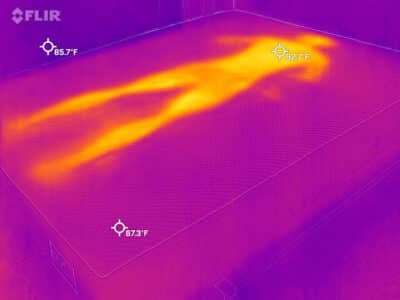
Spring
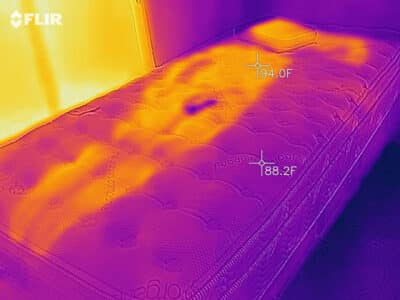
Memory foam has come a long way over the years though. Modern memory foam may offer improved cooling through a couple of strategies, ex: perforated or convoluted foam, gel-infused memory foam, or copper-infused foam.
Still, even with these advanced materials, it’s hard to completely offset the advantage of an open coil system when it comes to heat dissipation and breathability.
Do memory foam or spring mattresses have more sinkage?
In our tests, spring mattresses had slightly more sinkage than memory foam mattresses, but the exact sinkage depends on the mattress.
Memory Foam
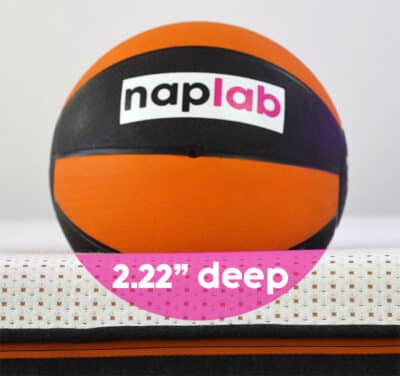
Spring
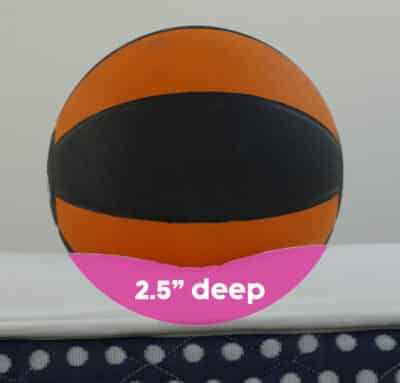
On average, we have measured 2.17″ of sinkage on all memory foam mattresses we’ve tested.
By comparison, on average, we have measured 2.65″ of sinkage on all spring mattresses we’ve tested. This is about a 0.5″ difference between the two types.
Do memory foam or spring mattresses have less motion transfer?
Memory foam mattresses typically have less motion transfer than spring mattresses. As you can see in the charts below, energy levels on the coil-based mattress (Saatva Classic) are greater and that energy extends for longer than it does on the memory foam mattress (Nectar Premier Copper).
Nectar Premier Copper Motion Transfer
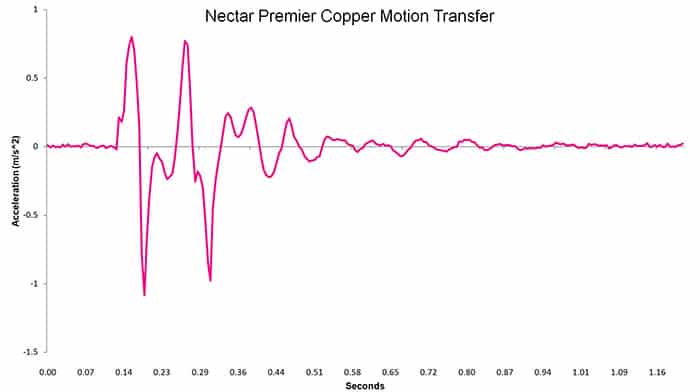
Saatva Classic Motion Transfer
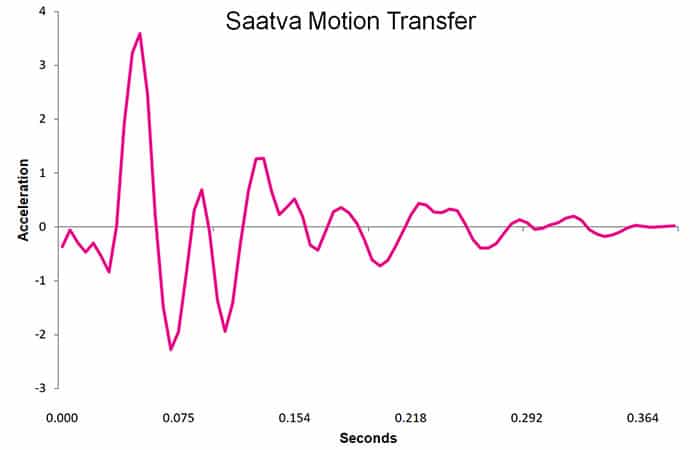
See the example video of motion transfer on the Ghostbed Luxe memory foam mattress below.
If you sleep with a partner or are easily disturbed by movements while you sleep, a memory foam mattress may be a better choice.
Spring mattresses or even hybrid mattresses are generally going to have more motion transfer because of the coil-based design.
For comparison, the video below show the motion transfer for Saatva Classic (a high-performance coil mattress).
Do memory foam or spring mattresses have a faster response time?
Spring mattresses generally have a faster response time than memory foam mattresses. See the example video of ultra slow response speed from the Nectar Classic below.
Traditional memory foam is designed to hug and contour your body. Because of these tendencies, it is often slower to react if you change positions. Coils, on the other hand, spring back to their original position almost instantaneously.
See the example video of fast response speed from the Winkbed below.
Do memory foam or spring mattresses have better edge support?
Spring mattresses usually have better edge support than memory foam mattresses.
The structure of a coil is just more supportive than most foams, especially when the weight of a whole body is applied specifically at the edge.
Memory Foam

Spring
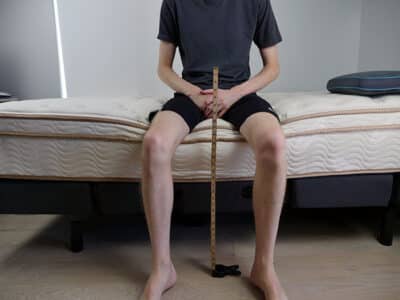
In our tests, memory foam mattresses had an average max sinkage of 5.21″ when sitting directly on the edge.
Comparatively, spring mattresses had a max sinkage of only 3.75″. This is a difference of nearly 1.5″. This much of a difference would certainly be noticeable when sitting at the edge.
Are memory foam or spring mattresses better for sex?
As you might expect, spring mattresses are generally better than memory foam mattresses for sex.
Memory foam is great for absorbing energy, motion, or sound. But for sex, more bounce and higher energy transfer can be more beneficial.
See the example video of low bounce levels from the Loom & Leaf below.
Spring mattresses have that fast response time, greater bounce, and just a more engaging surface on the mattress.
See the example video of high bounce levels from the Winkbed below.
When comparing scores side-by-side, memory foam mattresses had an average of 9.15 compared to the spring score of 9.68.
Do memory foam or spring mattresses have better pressure relief?
Memory foam and spring mattresses are both capable of creating a similar excellent level of pressure relief, although in our tests spring mattresses have historically been slightly better.
That said, based on my subjective experience of mattress tests over the last 8 years I would say that both high performance memory foam and high performance spring mattresses can create equally good levels of pressure relief.
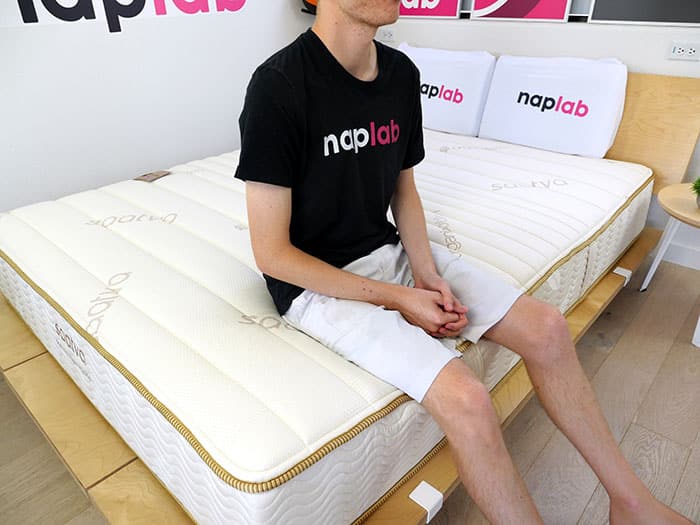
With spring mattresses, we oftentimes see good pressure relief because the coils are designed to evenly distribute weight and support the spine. Memory foam is certainly capable of providing similar levels of pressure relief, but it’s more dependent on the specific type of memory foam mattress and its firmness level.
Do memory foam or spring mattresses have faster off-gassing?
From our tests, we’ve found that spring mattresses off-gas faster than memory foam mattresses.
On average, memory foam mattresses smelled for 3.08 days, whereas spring mattresses smelled for an average of 0.5 days. If you’re ultra-sensitive to strong odors, a spring mattress would be the better pick here.
What is a memory foam mattress?
A memory foam mattress uses memory foam as the primary comfort layer, with support layers below.
It may include traditional poly foams, or high-density support foams, but the top comfort layer has the distinct feel of classic memory foam.

What is memory foam?
Memory foam is a polyurethane foam that blends various chemicals together chemicals to create a man-made composite foam material. Memory foam can also be called viscoelastic polyurethane foam.
In short, it’s the viscoelasticity that provides that classic memory foam feel—with a unique level of hug and body contouring.
What does memory foam feel like?
The feeling of memory foam is something that most sleepers can recognize. It’s marked by deeper contour.

As you compress memory foam, the foam begins to envelop around you, creating great pressure relief and deeper hug than a spring-based mattress. Memory foam tends to change slowly, but supports deeply.
Advantages of Memory Foam
#1. Deeper Hug
If you like the feeling of your mattress hugging you, memory foam is a great choice. The foam can support the curvature of your hips, spine, and shoulders to help relieve pressure points and provide deeper hug. This feeling can be especially beneficial for side sleepers.
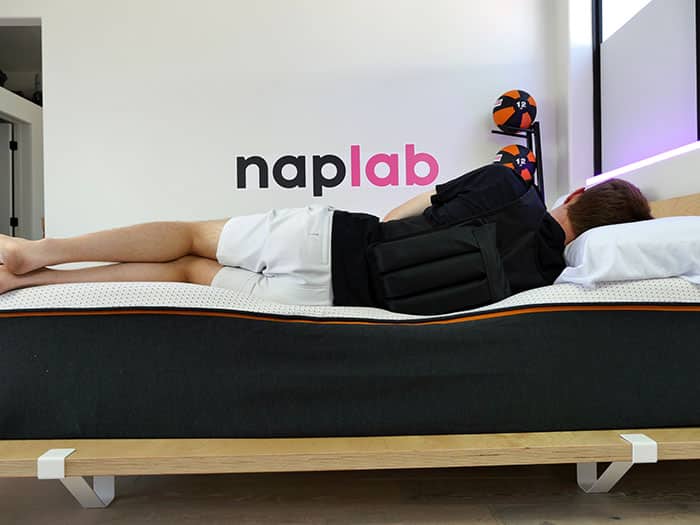
#2. Minimal Motion Transfer
Motion transfer on memory foam is far more restricted than what you’ll see on a spring-based mattress. The foam is designed to absorb and dissolve movements. In most motion transfer tests of memory foam mattresses, we see this trend.
For example, check out the motion transfer chart for the Ashley Sleep Gruve memory foam mattress.
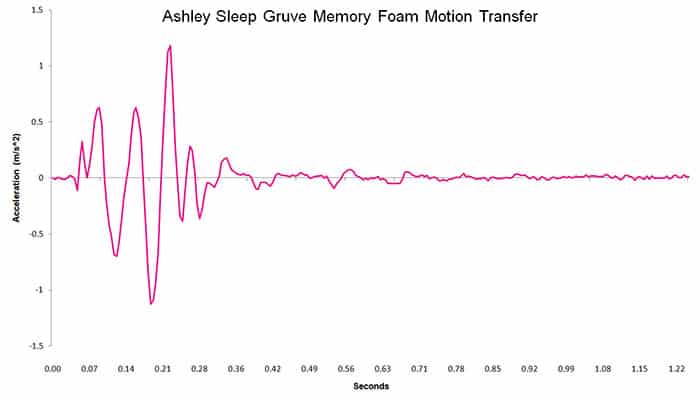
As you can see, the energy level has an initial spike, but that energy is quickly absorbed and by 0.6 second, it’s virtually gone.
For comparison, check out the same motion transfer test on a Winkbed spring mattress.
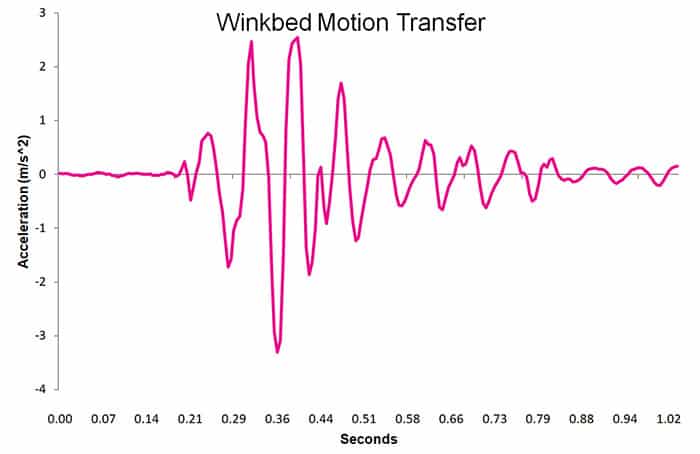
Not only is the spike greater, but the motion also continues for longer, continuing across the surface of the mattress.
Disadvantages of Memory Foam
#1. Heat Retention
One of the biggest pitfalls of traditional memory foam is heat retention. It’s just the nature of viscoelastic polyurethane foam.
These materials are more likely to struggle with heat build-up and are also less efficient at dissipating the heat in a reasonable time frame.

Some memory foams try and counteract this by having an open-cell structure or by including additives in the foam like cooling gel or a copper-infused composition.
#2. Poorer Edge Support
Another disadvantage of memory foam compared to coils is the edge support. Foams in general tend to struggle in this area, since additional pressure can really compress foam more easily than the same pressure would compress a spring.

Among all memory foam mattresses we’ve tested to date we do see a range of performance. Even though many memory foam mattresses struggle in this area, not all do.
Some mattresses have reinforced edges, which help counteract that compression or thinner comfort layers. For example, the organic BedInABox EcoLux, the Ghostbed Luxe, or the Novosbed mattress all had excellent edge performance with scores in the mid to upper 9’s.
What is a spring mattress?
A spring mattress (also sometimes called a coil mattress) is any mattress where the majority of layers are made up of coils or springs.
It’s important to note here, that in today’s market there are fewer and fewer true spring mattresses.

Most mattresses we test still have a thick foam comfort layer on the top, although support system uses springs / coils. It is a fine line between a spring mattress and a hybrid mattress.
Click here for a head-to-head look at memory foam vs. hybrid mattresses.
What does a spring mattress feel like?
Spring or coil mattresses tend to have high bounce, fast response, and a more active and engaging feel. These mattresses do not have the hug or contour of memory foam.
Types of Springs
There are four main types of springs or coils that are used in mattresses.
- Bonnell coil: an hourglass-shaped spring that is traditionally found in innerspring mattresses. The wider portion of these spring flexes easier and the narrower portion in the middle is denser, which provides a nice range of support and pressure relief.
- Offset coil: a close cousin to the Bonnell coil that shares the same hourglass shape. Despite the similarities in appearance, offset coils tend to be more responsive and quieter than Bonnells. At the top and bottom of these coils, there are squared-off corners (instead of round) which helps to improve performance.
- Continuous coil: created from one single continuous wire. These are the least expensive type of coil, but also tend to have worse performance due to the high levels of motion transfer and limited pressure relief.
- Pocketed coil: uses individual coils that are encased in a thin fabric (aka: pocket). When used in this way, coils can be virtually silent, limit motion transfer, and also improve pressure relief. Most of the spring and hybrid mattresses we review in the NapLab contain pocketed coils.

Honorable Mention: Microcoils
I can’t round out this section about coils without mentioning microcoils. Microcoils are commonly used in the comfort layer and are designed to enhance pressure relief and add to the overall dynamic feel of the mattress.

Microcoils may appear in traditional coil mattresses, under the phrase “coil-on-coil”, or nestled among the layers of a hybrid mattress (blend of foam and coils).
Advantages of a Spring Mattress
#1. Faster Response
Many times foam mattresses can have a slower response time. A spring mattress is going to respond a lot quicker and given the design, it makes sense.
When you lay on a spring mattress, the weight of your body makes the springs compress. The pressure holds the springs down and provides support. But when you get up, the spring is naturally designed to spring back to its original position.
This gives spring mattresses a fast response time and prevents feelings of excess hug, contour, or “feeling stuck” in the mattress.
#2. Improved Edge Support
Edge support is also typically better on a spring mattress than memory foam. The same reasons why springs have better response time also help with edge support.
When more weight is applied to the spring, that means more force is pushing back up on the spring, creating better edge support.
Check out the comparison below between the Nectar Premier vs. Winkbed Plus.

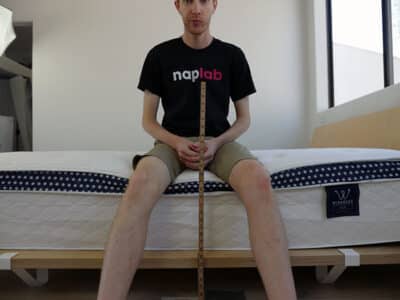
If you often find yourself sitting directly on the edge of the mattress, this could be an important factor for you.
Some foam mattresses offer coils at the perimeter for better edge support or even a high-density perimeter foam. This can be a good option to consider for best performance. Example: Saatva Memory Foam Hybrid
Disadvantages of A Spring Mattress
#1. More Motion Transfer + Bounce
With the advantage of fast response and good edge support, comes the disadvantage of more motion transfer and bounce. This is simply the nature of springs.
While high bounce isn’t necessarily always a bad thing, it could be if you prefer low bounce mattresses.
Pocketed coils will typically have less motion transfer than the other types of coils (Bonnell, Offset, or Continuous), but still probably more motion transfer than memory foam.
#2. Noise
Classic spring mattresses get a bad rap for being noisy and squeaky. And in some cases the reputation that precedes these mattresses is true. But not always.
If you’re looking for a silent mattress, memory foam is probably the better pick, but spring mattresses with pocketed or foam-encased springs as well as foam top comfort layers can be just as quiet as foam-based mattresses.

Which is right for you?
So you’ve made it this far… how do you know which mattress is right for you?
Memory foam mattresses are better if you’re looking for:
- More hug and contour
- Less bounce
- Minimal noise
- Less motion transfer
Spring mattresses are better if you’re looking for:
- Better cooling
- Faster response time
- Better edge support
- Better sex
FAQ
Depending on what you’re looking for, each mattress has distinct advantages and disadvantages. For contour and hug, go with memory foam. For bounce, cooling, and response, go with spring.
Generally, foam mattresses can be expected to last 8-10 years. A spring mattress lasts 7-10 years. And a hybrid would be around the same — 8-12 years. All that being said, the exact lifespan of any mattress depends on your body weight, sleeping position, foundational support, frame, environment, care, and the specific mattress.
Most hotels change their mattresses every 3-5 years, although the exact timetable may vary based on brand, location, usage, clientele, and turnover.
A hybrid mattress uses a blend of both foam and springs to provide comfort and support. If you’re not sure which mattress to pick, consider a memory foam hybrid that has a memory foam comfort layer with a spring support layer, like the Bear Elite hybrid mattress.
Not always. A low-quality spring mattress may squeak or one that does not have enough material between the coils and the sleeper. Pocketing coils or wrapping them in foam are two good ways manufacturers can limit squeaky coils.
Firmness is not determined by mattress type. There are ultra soft and ultra firm memory foam and spring mattresses, and every firmness in between.






